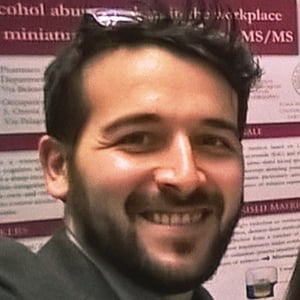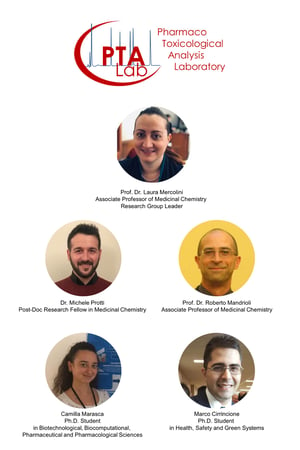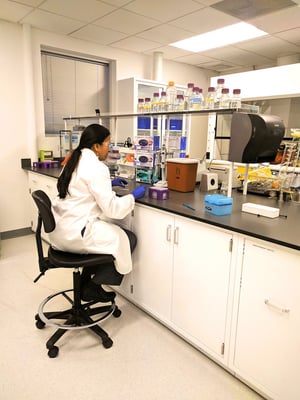Share this
the dried blood sampling landscape: Michele Protti, PhD, on microsampling
by Neoteryx Microsampling on Nov 14, 2019 4:30:00 AM
At Neoteryx, we work with top scientists and researchers to help facilitate and promote their revolutionary work using Mitra® microsampling devices and Volumetric Absorptive Microsampling technology.
 One such thought leader is Michele Protti, PhD, at the University of Bologna. Together with Professor Laura Mercolini and others, he has performed and published lots of important work using microsampling, and recently presented his work on peptides at TIAFT.
One such thought leader is Michele Protti, PhD, at the University of Bologna. Together with Professor Laura Mercolini and others, he has performed and published lots of important work using microsampling, and recently presented his work on peptides at TIAFT.
In this interview, he provides insight on his work using VAMS®, plus some guidance for other scientists and researchers who may want to follow his lead. His remarks have been edited for clarity and length.
Can you describe your work with VAMS® technology?
One of the latest projects carried out by the research group of Pharmaco-Toxicological Analysis (PTA Lab), headed by Professor Laura Mercolini at the Department of Pharmacy and Biotechnology (FaBiT) of the Alma Mater Studiorum - University of Bologna, focused on the analysis of several compounds in biological matrices sampled through innovative microsampling strategies.
After carefully tuning all the parameters involved in sampling, storage, and extraction, we focused on an in-depth stability study. One of the main bits of information we wanted to obtain from this research was the possible stability enhancement of several molecules in samples collected by dried microsampling. Comparing it with the results obtained from classical matrices in fluid form stored at controlled temperatures allowed us to evaluate pros and cons of each approach.
Why did you first consider using VAMS® for this work?
 In recent years, we have acquired solid expertise in the study and development of methodologies based on VAMS® technology, which has also allowed us to publish a tutorial paper available to the scientific community. In that tutorial, we gathered all the information and useful insights to date to carry on studies based on this innovative sampling approach.
In recent years, we have acquired solid expertise in the study and development of methodologies based on VAMS® technology, which has also allowed us to publish a tutorial paper available to the scientific community. In that tutorial, we gathered all the information and useful insights to date to carry on studies based on this innovative sampling approach.
One of the common threads of the studies we have undertaken so far on some compound classes has been the stability enhancement. We observed how, for many compounds prone to degradation in fluid samples, this phenomenon was blocked or at least slowed down when classic samples were turned into microsamples in solid form.
Consequently, we decided to exploit this advantage to broaden the set of tested compounds, especially those featuring intrinsic low stability. There are many bioanalytical fields in which the pre-analytical steps could potentially jeopardize results reliability due to possible false negatives caused by the degradation of compounds in the samples before analysis.
Can you describe your experience using VAMS® in the course of your latest research?
All the useful preliminary information on the devices had already been studied in depth by the PTA Lab research group at the beginning of our research using VAMS®. Since then, we have been able to focus on the development of methodologies aimed at quali-quantitative analysis in such microsamples.
Biomarker analysis by chromatography and mass spectrometry can sometimes be tricky, especially when dealing with biological samples. But in this regard, VAMS® technology has allowed us a rapid and effective tuning and validation process, providing a boost to all the optimization steps. In this way, we were able to concentrate on the stability study with a solid and reliable methodology available.
What were you able to accomplish using VAMS® that you may not have otherwise?
One of the greatest advantages I have been able to appreciate more about VAMS® technology is the simplicity and rapidity of use, while maintaining high performance and guaranteeing the reliability of quali-quantitative analytical data.
This allows us, whenever we are dealing with experimental design and development of procedures within the context of a new research, to envisage a large number of experimental assays. This allows us to obtain results in shorter timeframes and at the same time to finely optimise each single parameter involved in all the pre-analytical and analytical steps, tailoring ad-hoc, high-performance methodologies each time.
What was your biggest surprise while doing this work?
 When dealing with complex biological matrices, regardless of the sampling method, we must always take into account the need to employ additional clean-up steps in order to obtain sufficiently purified extracts from potential interference, especially when it is necessary to meet high sensitivity and selectivity standards.
When dealing with complex biological matrices, regardless of the sampling method, we must always take into account the need to employ additional clean-up steps in order to obtain sufficiently purified extracts from potential interference, especially when it is necessary to meet high sensitivity and selectivity standards.
One of the biggest surprises within this work was the possibility of obtaining sufficiently clean extracts by fine-tuning extraction solvents, in order to find the best compromise between extraction yield and sample clean-up. This has led us to a further simplification of the procedures and the reduction of total analysis time.
What are the broader implications of your work?
It is my opinion that in the next few years VAMS® could become an interesting part of the sampling landscape, and full automation will become the next frontier for its use.
Despite its relatively recent introduction, in the last years VAMS® has already contributed to several bioanalytical success stories.
Until now, the main field for VAMS® application is the monitoring of small drug molecules and almost all the work done deals with this kind of analytes. However, a few different applications have begun to appear, from the analysis of peptides and proteins, to the forensic analysis of drugs of abuse and anti-doping testing.
In just few years, VAMS® has come a long way, but a lot of work has still to be done both in the academic and the industrial communities. In my opinion, the results obtained recently by the PTA Lab research group and the whole bioanalytical community in the framework of microsampling are very promising and offer interesting perspectives for the scientific framework.
What advice would you give to colleagues who are interested in using microsampling technology?
When dealing with cutting-edge approaches like microsampling, scientists should keep in mind that data integrity and results reliability must come at the first place. In order to obtain sound and robust features in terms of quali-quantitative results, methodical approach to validation and bridging studies is fundamental.
Good result agreement between classical methods and newly developed ones will strongly corroborate their actual reliability when put into practice in the real world out of the laboratory. Also, I feel it is important to ‘convince’ the people who will have to implement such techniques, that microsampling is the ultimate way ahead to break free from obsolete and troublesome practices.
The Microsampling Work of Michele Protti, PhD
- Michele Protti, Roberto Mandrioli, & Laura Mercolini. Tutorial: Volumetric absorptive microsampling (VAMS). Analytica Chimica Acta 1046 (2019) 32-47.
- Michele Protti, Maria Carmen Catapano, Boaz Gedaliahu Samolsky Dekel, James Rudge, Gilberto Gerra, Lorenzo Somaini, Roberto Mandrioli, & Laura Mercolini. Determination of oxycodone and its major metabolites in haematic and urinary matrices: Comparison of traditional and miniaturised sampling approaches. Journal of Pharmaceutical and Biomedical Analysis 152 (2018) 204-214.
- Michele Protti, Alice Vignali, Teresa Sanchez Blanco, James Rudge, Francesca Bugamelli, Anna Ferranti, Roberto Mandrioli & Laura Mercolini. Enantioseparation and determination of asenapine in biological fluid micromatrices by HPLC with diode array detection. Journal of Separation Science 41 (2018) 1257-1265.
- Michele Protti, James Rudge, Angelo Eliseo Sberna, Gilberto Gerra & Laura Mercolini. Dried haematic microsamples and LC– MS/MS for the analysis of natural and synthetic cannabinoids. Journal of Chromatography B 1044-1045 (2017) 77-86.
- Laura Mercolini, Michele Protti, Maria Carmen Catapano, James Rudge, & Angelo Eliseo Sberna. LC-MS/MS and volumetric absorptive microsampling for quantitative bioanalysis of cathinone analogues in dried urine, plasma and oral fluid samples. Journal of Pharmaceutical and Biomedical Analysis 123 (2016) 186-194.
- Laura Mercolini & Michele Protti. Biosampling strategies for emerging drugs of abuse: towards the future of toxicological and forensic analysis. Journal of Pharmaceutical and Biomedical Analysis 130 (2016) 202-219.
- Laura Mercolini, Maria Addolorata Saracino, Michele Protti. Current advances in biosampling for therapeutic drug monitoring of psychiatric CNS drugs. Bioanalysis 7 (2015) 1925-1942.
- Presentation - VAMS Multimatrix Approach for the Analysis of Synthetic Drugs of Abuse (Laura Mercolini, University of Bologna)

Share this
- Microsampling (206)
- Research, Remote Research (119)
- Venipuncture Alternative (105)
- Clinical Trials, Clinical Research (83)
- Mitra® Device (73)
- Therapeutic Drug Monitoring, TDM (51)
- Dried Blood Spot, DBS (39)
- Biomonitoring, Health, Wellness (30)
- Infectious Disease, Vaccines, COVID-19 (24)
- Blood Microsampling, Serology (23)
- Omics, Multi-Omics (21)
- Decentralized Clinical Trial (DCT) (20)
- Specimen Collection (18)
- Toxicology, Doping, Drug/Alcohol Monitoring, PEth (17)
- Skin Microsampling, Microbiopsy (14)
- hemaPEN® Device (13)
- Preclinical Research, Animal Studies (12)
- Pharmaceuticals, Drug Development (9)
- Harpera Device (7)
- Industry News, Microsampling News (5)
- Antibodies, MAbs (3)
- Company Press Release, Product Press Release (3)
- Environmental Toxins, Exposures (1)
- July 2025 (1)
- May 2025 (1)
- April 2025 (2)
- December 2024 (2)
- November 2024 (1)
- October 2024 (3)
- September 2024 (1)
- June 2024 (1)
- May 2024 (1)
- April 2024 (4)
- March 2024 (1)
- February 2024 (2)
- January 2024 (4)
- December 2023 (3)
- November 2023 (3)
- October 2023 (3)
- September 2023 (3)
- July 2023 (3)
- June 2023 (2)
- April 2023 (2)
- March 2023 (2)
- February 2023 (2)
- January 2023 (3)
- December 2022 (2)
- November 2022 (3)
- October 2022 (4)
- September 2022 (3)
- August 2022 (5)
- July 2022 (2)
- June 2022 (2)
- May 2022 (4)
- April 2022 (3)
- March 2022 (3)
- February 2022 (4)
- January 2022 (5)
- December 2021 (3)
- November 2021 (5)
- October 2021 (3)
- September 2021 (3)
- August 2021 (4)
- July 2021 (4)
- June 2021 (4)
- May 2021 (4)
- April 2021 (3)
- March 2021 (5)
- February 2021 (4)
- January 2021 (4)
- December 2020 (3)
- November 2020 (5)
- October 2020 (4)
- September 2020 (3)
- August 2020 (3)
- July 2020 (6)
- June 2020 (4)
- May 2020 (4)
- April 2020 (3)
- March 2020 (6)
- February 2020 (3)
- January 2020 (4)
- December 2019 (5)
- November 2019 (4)
- October 2019 (2)
- September 2019 (4)
- August 2019 (4)
- July 2019 (3)
- June 2019 (7)
- May 2019 (6)
- April 2019 (5)
- March 2019 (6)
- February 2019 (5)
- January 2019 (8)
- December 2018 (3)
- November 2018 (4)
- October 2018 (7)
- September 2018 (6)
- August 2018 (5)
- July 2018 (8)
- June 2018 (6)
- May 2018 (5)
- April 2018 (6)
- March 2018 (4)
- February 2018 (6)
- January 2018 (4)
- December 2017 (2)
- November 2017 (3)
- October 2017 (2)
- September 2017 (4)
- August 2017 (2)
- July 2017 (4)
- June 2017 (5)
- May 2017 (6)
- April 2017 (6)
- March 2017 (5)
- February 2017 (4)
- January 2017 (1)
- July 2016 (3)
- May 2016 (1)
- April 2016 (2)


No Comments Yet
Let us know what you think